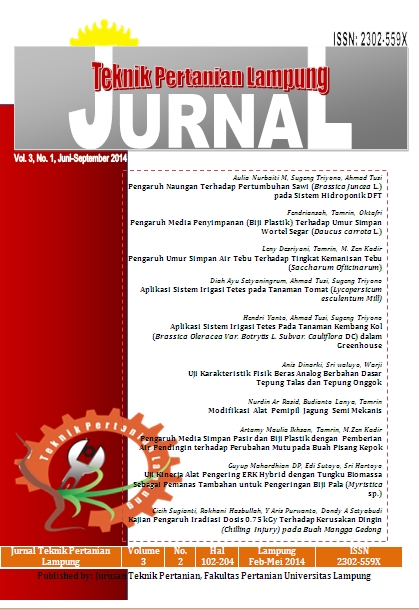THE APPLICATION OF DRIP IRRIGATION SYSTEM ON CAULIFLOWER (Brassica Oleracea Var. Botrytis L. Subvar. Cauliflora DC) IN AGREENHOUSE
Abstract
The research aimed to test performance of a drip irrigation system to irrigate cauliflower cultivated in a greenhouse. The drip irrigation system using emitter type regulating stick emitter as many 315. One Main pipe, one manifold, and four lateral pipes were from PE types with the diameter of 13 mm. The methods to deliver irrigation water were by using a small pump 13 Watt and by using gravitational pressure with head 155 cm. Variables observed were emission uniformity (EU), water requirement, plant growth, and water productivity. The results showed that Emission uniformities were 64,49 % for gravitational flow and 61,46 % for pumping flow. These values were still below recommended, that is 75 % - 85 %. The minimum, maximum, and mean reference evapotranspiration (ETo) were recorded as 5,80 mm/day, 9,70 mm/day, and 7,20 mm/day. Whilst crop evapotranspiration (ETc) at the day of 41 after planted was 3.2 mm/day. Average yield of cauliflower was 58 gram per plant, while water productivity was 0,87 gram/litter.Keyword: cauliflower, crop water requirement, drip irrigation, emitter, emission uniformity
Downloads
Published
2014-09-30
Issue
Section
Articles
License
- Authors who publish with this journal agree to the following terms:
- Authors retain copyright and grant the journal right of first publication with the work simultaneously licensed under a Creative Commons Attribution-ShareAlike 4.0 International Lice that allows others to share the work with an acknowledgement of the work's authorship and initial publication in this journal.
- Authors are able to enter into separate, additional contractual arrangements for the non-exclusive distribution of the journal's published version of the work (e.g., post it to an institutional repository or publish it in a book), with an acknowledgement of its initial publication in this journal.
- Authors are permitted and encouraged to post their work online (e.g., in institutional repositories or on their website) prior to and during the submission process, as it can lead to productive exchanges, as well as earlier and greater citation of published work (See The Effect of Open Access).
Jurnal Teknik Pertanian Lampung

JTEPL is licensed under a Creative Commons Attribution-ShareAlike 4.0 International License.

